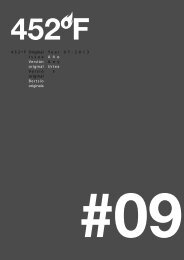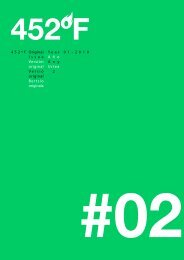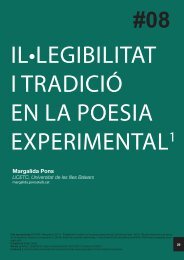03 - 452ºF
03 - 452ºF
03 - 452ºF
Create successful ePaper yourself
Turn your PDF publications into a flip-book with our unique Google optimized e-Paper software.
There were moves by some writers to combat this discrimination.<br />
Some female writers, such as the Brontës, for instance, «sought<br />
ineffectively to veil themselves [and thus their gender] by using the<br />
name of a man» (Woolf, 2000: 52), in the hope that their work would<br />
gain respect and recognition, or at least be given a chance, on the<br />
basis that it was supposedly written by a man. Ironically, however,<br />
this resulted in female writers paying «homage to the convention»<br />
(Woolf, 2000: 52) whereby the writers were, in effect, unconsciously<br />
encouraging the tradition of male writers being «superior», and<br />
female writers soon reverted to letting their identities be known and<br />
attempted to be published under their own names. This, however, was<br />
just the start of more problems that female writers would experience.<br />
The opening quote by Joanna Russ describes only one such problem:<br />
that, historically, «there [were] so very few stories in which women<br />
can figure as protagonists» (Russ, 1995: 80) as female characters<br />
traditionally existed only in relation to the (male) hero. It was long the<br />
situation that female characters in novels had the choice of playing one<br />
of only two possible types of role: «the vexed and vexing polarities of<br />
angel and monster, sweet dumb Snow White and fierce mad Queen»<br />
(Gilbert, 1979: 21), thus providing very limited possibilities for female<br />
characters to truly shine. Related to this, was the apparent lack of<br />
female literary predecessors whose lead other female writers could<br />
follow. This resulted in women’s writing becoming «at least bitextual;<br />
[...] it is a double-voiced discourse influenced by both the dominant<br />
masculine literary tradition and the muted feminine one» (Showalter,<br />
2009: xv). After all, as Joanna Russ points out, the «insistence<br />
that authors make up their own plots is a recent development in<br />
literature [...] It’s a commonplace that bad writers imitate and great<br />
writers steal» (Russ, 1995: 85-86). This, then, posed a problem for<br />
upcoming female writers, whose predecessors were predominantly<br />
male and who, naturally, would have different experiences to write<br />
about. The alternative for women, then, was «to take as one’s model<br />
(and structural principle) not male myth but the structure of one’s<br />
own experience» (Russ, 1995: 88). After all, women would logically<br />
experience somewhat «different» lives from men, whether concerning<br />
ambitions and problems, the body and work, or societal expectations<br />
and restrictions. Therefore, it seems only natural that these issues<br />
would begin to appear in writing by the women who are likely to have<br />
witnessed or experienced them:<br />
The differences between traditional female preoccupations and roles<br />
and male ones make a difference in female writing. Many other critics<br />
are beginning to agree that when we look at women writers collectively<br />
we can see an imaginative continuum, the recurrence of certain<br />
patterns, themes, problems, and images from generation to generation.<br />
(Showalter, 2009: 9)<br />
Trivial or Commendable? : Women’s Writing, Popular Culture, and Chick Lit - Mary Ryan<br />
<strong>452ºF</strong>. #<strong>03</strong> (2010) 70-84.<br />
78










